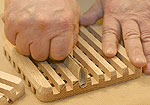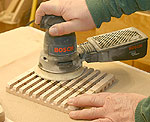This is a Veteran Owned site
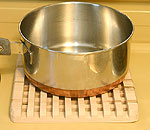 |
These "waffle" trivets are easy to make and are useful in the home or as gifts. Click image to enlarge |

Table Saw Trivets
Simple, useful projects for the home or gifts
Text & Photos by Tom Hintz
Warning: Even though the dado blade is essentially buried during the process described below, the operator must use a good push handle or push block to protect their hands in case the wood fractures or something else unexpected occurs. Be safe first!
Trivets have been around as long as hot pots. Though more often associated with the lathe, attractive trivets can be made on the table saw using a good quality stacked dado cutter.
The exposed waffle pattern is a classic that looks more difficult to make than it is. We use one cutter width and one height to make all of the cuts. The trick is in remembering how to turn and flip the piece after the initial center cuts are made.
The Material
The trivets in this story were made from 6 1/4"-square, ¾"-thick red oak but virtually any hardwood will work. I consider ¾" to be the minimum thickness for trivets. Wood thicknesses up to 1 ½" work but we have to remember that as the depth of the cuts increase, safety becomes an issue. Using a good quality, sharp stacked dado set and good hand protection make this, and any dado work, a much safer task.
The material for this project was cut to 6 1/4"-square because both sides can be cut exactly the same and that shape is the most useful for setting hot pots on. I have seen rectangular waffle-cut trivets but making them gets more dangerous as the blade-to-fence distance increases. Also, the top and bottom sides have to be cut individually which complicates the process somewhat.
Saw Setup
 |
Centering the wood on the blade sets the initial fence position. Click image to enlarge |
All of the cuts are made with a 3/8"-wide dado stack, set to a height slightly higher than one half of the materials thickness. Use a piece of scrap the same thickness as the work pieces to find the height that clears the material where the cuts intersect. When the cutter is 1/16" to 1/8" higher than halfway through the wood, the cuts come out cleaner.
To set the initial fence distance, mark the center of the blank and adjust the fence so that mark is in the middle of the dado stack. Get this setting as close as possible by eye. The first set of cuts will center this first groove.
Making the Waffle Cuts
 |
The initial cuts center the first groove by cutting, turing 180-degrees and cutting again. All other cuts are made in one pass. Click image to enlarge |
The hardest part of making Table Saw Trivets is making the cuts in the right places. Forgetting where you are and turning the piece the wrong way is easy, so take your time and be sure of each cut before making it.
Make the first cut, turn the piece 180-degrees and make a second pass to center the groove. Flip the piece upside down and turn it so that the first cut is on top and 90-degrees to the blade. Make the same two cuts to make the first groove on that side. From this point, only one pass will be made for each groove.
Move the fence closer to the blade by ¾". Make sure the groove on the bottom of the piece runs parallel to the blade (easy mistake here), make one pass, turn the piece 180-degrees and make the second cut. If you did everything right, these new cuts produced grooves 3/8" to the outside of the center groove. Turn the piece upside down, the groove parallel to the blade and make the second cuts on that side.
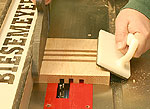 |
Remembering to keep the groove oriented correctly during the remaining cuts is probably the hardest part of this project. Take your time! Click image to enlarge |
Move the fence ¾" closer to the blade and repeat the two cut process on both sides, taking care to orient the grooves parallel to the blade before each pass. If the blank was 6 ¼"-square, you should end up with three grooves to either side of the center groove and a solid lip at the outside approximately 5/8" wide. That lip will provide the strength needed to help resist warping and cracking.
Sanding & Finishing
Sanding the grooves was easiest with a piece of 150-grit paper folded several times. If the dado stack was sharp, the amount of sanding needed will not be great. Also, some splintering where the grooves meet is normal and I broke them out with a piece of small-diameter dowel.
Finally, I used my Bosch ROS with a 220-grit disk installed to round the upper edges (choose the best looking face for the top) and sand all surfaces smooth. Rounding the upper edges makes the 5/8" lip appear narrower and makes the trivet look more finished.
I normally do not apply a finish to my trivets but some do. It is important to not to use wax-based finishes, as they will transfer to the bottom of hot pots placed on it. A good quality, food-safe (Salad Bowl Finish), allowed to dry completely before use should provide the protection needed.
Options
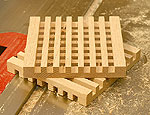 |
Once you get the hang of how to position the piece for the next cut, making these trivets is very fast and easy. Use good hand protection and pay attention! Click image to enlarge |
Trivets can be made on the table saw in various sizes and thicknesses. I like the 3/8"-wide grooves but you may have other ideas. The important thing to remember is that the fence adjustments between cuts should be twice the width of the groove used. Different widths and blank dimensions may result in a different lip at the outside edges. Leave whatever lip appears rather than cutting a full or partial groove along the edge.
These trivets make great gifts and use up scrap in a useful way. As long as you are safe when making them, trivets are fun to make as well.
Do you have a comment about this story? - Email Me!
Back to the Projects Directory
All written, photographic and drawn materials are property of and copyright by NewWoodworker.com LLC 2000-2019. Materials may not be used in any way without the written permission of the owner.

